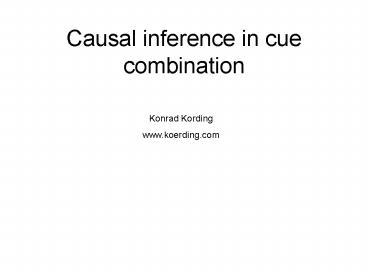Causal inference in cue combination PowerPoint PPT Presentation
Title: Causal inference in cue combination
1
Causal inference in cue combination
Konrad Kording www.koerding.com
2
Modeling Where do cues come from?
Generate
3
Traditional Bayesian model
Infer
Alais Burr 04, Battaglia et al 03, Knill
Pouget 04, Ernst Banks 02, Gahramani 95, van
Beers et al, etc
4
Visual Auditory combination (Ventriloquist effect)
Both cues
5
What would happen now?
6
Do we believe this kind of model?
Assumes there is one and only one cause!
7
Alternative model
or
Kording, Beierholm, Ma, Quartz, Tenenbaum, Shams,
2007
8
Calculate probability of model
- Using Bayes rule
9
Independent causes where is the auditory
stimulus
Audio Visual
Best estimate
10
Common cause where is the auditory stimulus
Audio Visual Combined
Best estimate
11
Mean squared error estimate
Audio Visual Combine
Best estimate
Remark Knill uses virtually identical math
12
Experimental test
Button common cause or two
Wallace et al 2005 Hairston et al 2004
13
Measured gain
Data
Kording et al
Sato et al, in press
Wallace et al 2005 Hairston et al 2004
14
How can the gain be negative?
15
Predicting the variance
Worse prediction if we assume model selection
16
Take home message
- Uncertainty about causal structure
- Bayesian framework is modular
- Easy to extend
- Causality problems occur in many domains
17
Acknowledgements
- Ulrik Beierholm
- Wei Ji Ma
- Steven Quartz
- Joshua Tenenbaum
- Ladan Shams
- Kunlin Wei
PowerShow.com is a leading presentation sharing website. It has millions of presentations already uploaded and available with 1,000s more being uploaded by its users every day. Whatever your area of interest, here you’ll be able to find and view presentations you’ll love and possibly download. And, best of all, it is completely free and easy to use.
You might even have a presentation you’d like to share with others. If so, just upload it to PowerShow.com. We’ll convert it to an HTML5 slideshow that includes all the media types you’ve already added: audio, video, music, pictures, animations and transition effects. Then you can share it with your target audience as well as PowerShow.com’s millions of monthly visitors. And, again, it’s all free.
About the Developers
PowerShow.com is brought to you by CrystalGraphics, the award-winning developer and market-leading publisher of rich-media enhancement products for presentations. Our product offerings include millions of PowerPoint templates, diagrams, animated 3D characters and more.

